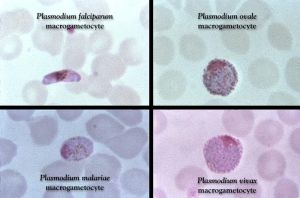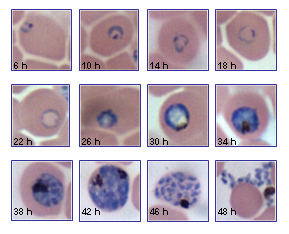Wikisage, the free encyclopedia of the second generation, is digital heritage
Plasmodium falciparum

| plasmodium Pl falciparum (William H. Welsh) | ||||
 | ||||
| Reich | protozoan | Protozoa | ||
| Stamm | ,,, | Apicomplexa | ||
| Klasse | ,,, | Aconoidasida | ||
| Ordnung | Haemosporida | |||
| Familie | Plasmodiidae | |||
| Gattung | Plasmodium | Plasmodium | ||
| Art | ,,, | Pl.falciparum | ||
| Unterarten | Plasmodium falciparum | |||
| Autor(en) | W H Welsh | |||
| Jahr | 1897 | |||
Plasmodium falciparum is a protozoan parasite, one of the species of Plasmodium that cause malaria in humans. It is transmitted by the female Anopheles mosquito. This species causes the disease's most dangerous form, malignant or falciparum malaria. It has the highest complication rates and mortality. Around the world, malaria is the most significant parasitic disease of humans and claims the lives of more children worldwide than any other infectious disease.
The 2015 World Health Organization report found 214 million cases of malaria worldwide. This resulted in an estimated 438,000 deaths. Rates of infection decreased from 2000 to 2015 by 37%, but increased from 2014's 198 million cases. In sub-Saharan Africa, over 75% of cases were due to P. falciparum, whereas in most other malarial countries, other, less virulent plasmodial species predominate. Almost every malarial death is caused by P. falciparum.
Links
Gardner M J et al 2002 Genome sequence of the human malaria parasite Plasmodium falciparum Nature 419
Martisen Ellen et al.2008 A three-genome phylogeny of malaria parasites (Plasmodium and closely related genera): Evolution of life-history traits and host switches Mol Phylogenetic and Evol.47 261-273
